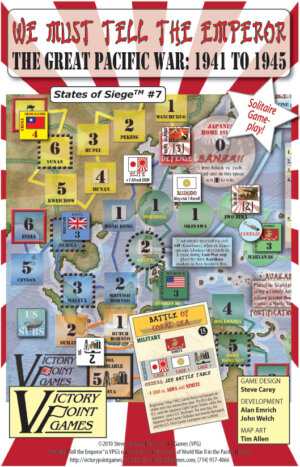
Publisher: Victory Point Games
Designer: Steve Carey
Year: 2011
Players: Solitaire game
Ages: 12+
Playing time: Around 60 minutes
Genre: Solo Pacific WWII game, from the viewpoint of the Japanese
MSRP: $22.95
We Must Tell the Emperor shares many qualities with previous releases within VPG’s States of Siege line: Event cards that drive much of the action, do or die rolls that can change your fortunes in an instant, as well as finding yourself representing some force with the odds stacked against you. WMTtE does bring a few new wrinkles to the line and brings the series to a new level of engagement.
As with all VPG releases, the rules are well organized and clearly presented. There are only eight pages to work through with examples of play scattered throughout and the final page devoted to a walk-through of a turn. You should have a firm grasp of the rules by the midpoint of your first game and, if need be, many of the rules you’ll refer to are located on the map or the battle sheet. The formatting of the rulebook also makes locating the answer to any particular question quite easy.
If you’ve played any previous States of Siege game you’ll be able to jump right into We Must Tell the Emperor.
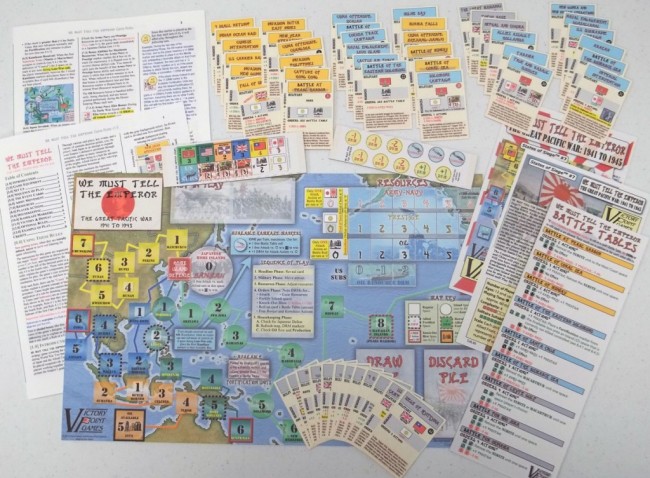
The player finds themself leading the Japanese military in the Pacific theatre during WWII. To win, the empire must survive and to do so you must still be standing after the last event card has been resolved or, less likely, you’ve temporarily knocked out three of your four opponents making their way toward your home islands. The odds are stacked against you as you can lose the game if you run out of both your army/navy and oil resources (a third resource, prestige, can be reduced to zero without losing the game) or if any of the various forces on four fronts take possession of the Japanese home islands.
The gameplay is fairly similar to other SoS titles as you’ll begin each turn by drawing an event card, moving your opponents along their track of approach (as indicated on the event card), applying any resource adjustments and/or die roll modifiers from the event, and then the player will have a limited (and changing) number of actions they may take.
After each item on the event card – which includes flavor text regarding the historical event taking place – has been resolved you’ll engage in a quick housekeeping phase before moving on to the turning of the next card. These cards are nicely laid out and you’ll find following the instructions quite simple.

A new addition not found in previous SoS titles is the Battles Table. When a battle event takes place, you may decide to tempt fate by spending an action to gain additional advantages from victory or minimize the losses of defeat. Choose this option wisely as you’ll find the sweet taste of victory turn to ashes in your mouth with a bad roll of the die.
With the actions available you may attack any one of the forces approaching (The Chinese, British, or the Americans under Nimitz or MacArthur) in order to drive them back or even temporarily knock them out of the game. Each of these forces may be attacked once each turn. You may also roll to increase your resources, fortify islands, or push your luck if a battle event has been turned. You’ll find that you never have enough actions available for what you need to achieve so every turn of a card brings with it a multitude of decisions. Add to this the fact that poor die rolls can leave you in an even tougher bind and you’ll see that the tension level of WMTtE quite high.
There’s plenty to mull over each and every turn. Do you spend actions to possibly increase resources? Will you focus on slowing down the American advance by building fortifications? What about the British and Chinese? You best knock the out Dutch ASAP because you can’t attempt to gain oil resources until you do. Don’t get too cocky if all goes well early on because the Allies can be an unstoppable juggernaut.
I’ll note that designer Steve Carey himself pointed out that he wins only about ten percent of the time – and this is his own design! So don’t expect to knock it out of the park every time you bring WMTtE to the table. If you’re like most gamers the experience of the game (or to steal a line from VPG, “The gameplay is the thing!”) is more important than simply winning or losing. Many of our favorite games tend to weave some sort of story or create a running narrative and this release does that extremely well. Even following a crushing defeat you’ll have a tale to tell!
All in all it’s obvious why We Must Tell the Emperor is the top selling game over at VPG. The action is tense, the choices are many, historical accuracy is there with enough random chaos added to boost replayablity. Designer Steve Carey has brought over 30 years of gaming experience to bring us a quick playing, yet meaty, experience of the Japanese-centric Pacific theatre to our table tops.
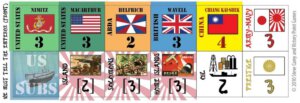
It’s important to note that, even though there is an expansion available for We Must Tell the Emperor, the game itself has all you need and all you’ll ever need. Or as Steve Carey told me, the game itself is your steak and potatoes (and it is truly a well done steak) but if you’re in the mood for a bit of dessert the expansion is available too.
[rwp-review id=”0″]
- Tales of Argosa: Caverns of Shennog Reviewed - Apr 17, 2025
- Castles & Crusades Reforged: Monsters & Treasure Reviewed - Apr 16, 2025
- Pathfinder NPC Core Reviewed - Apr 15, 2025




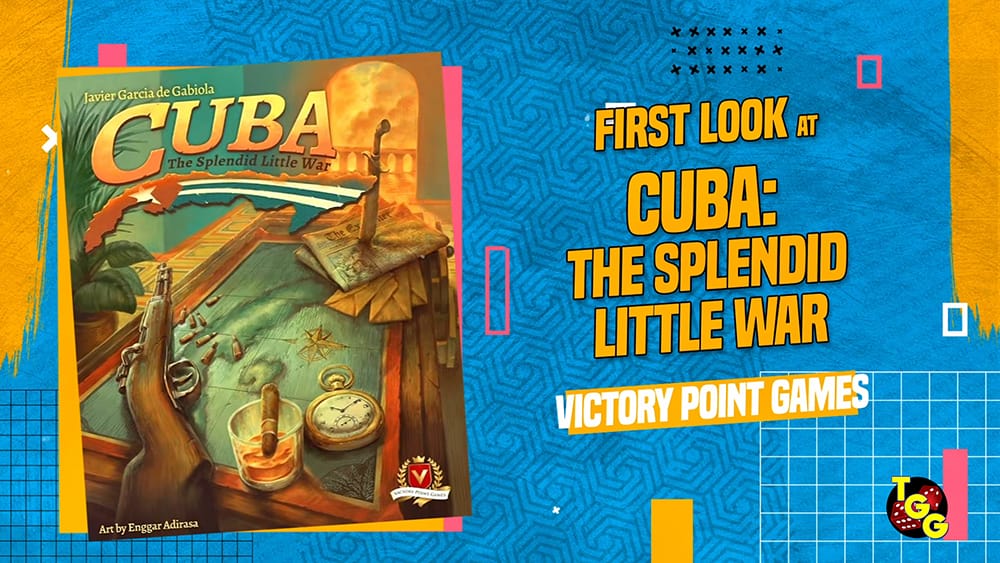
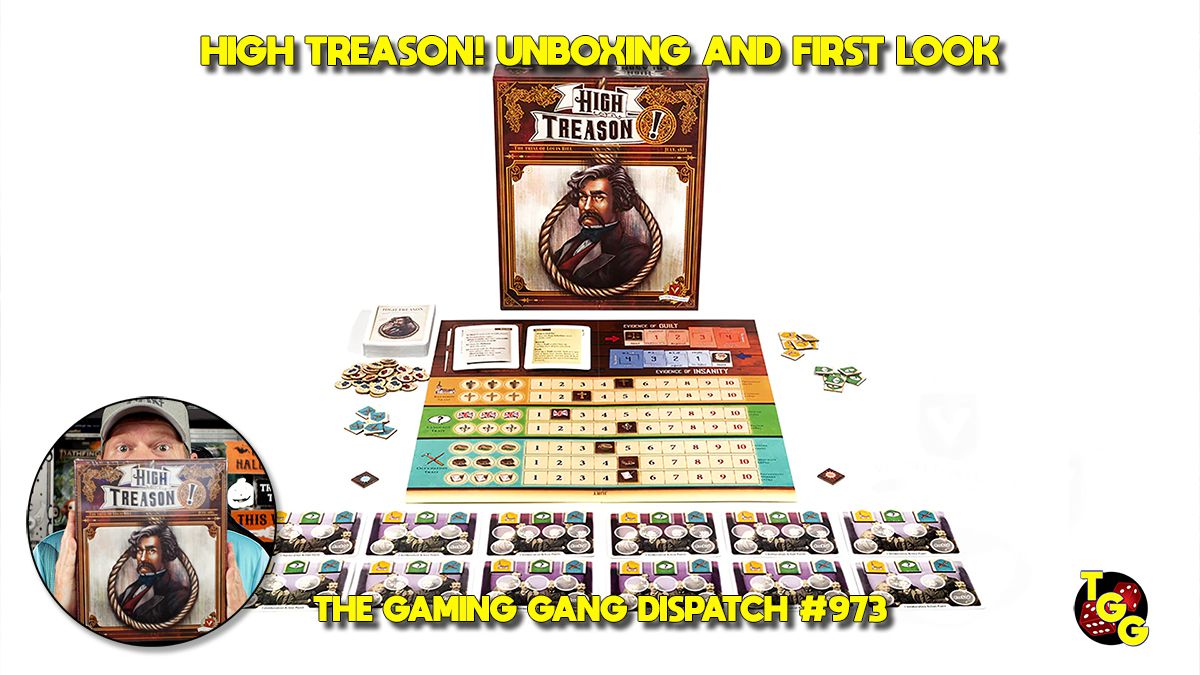
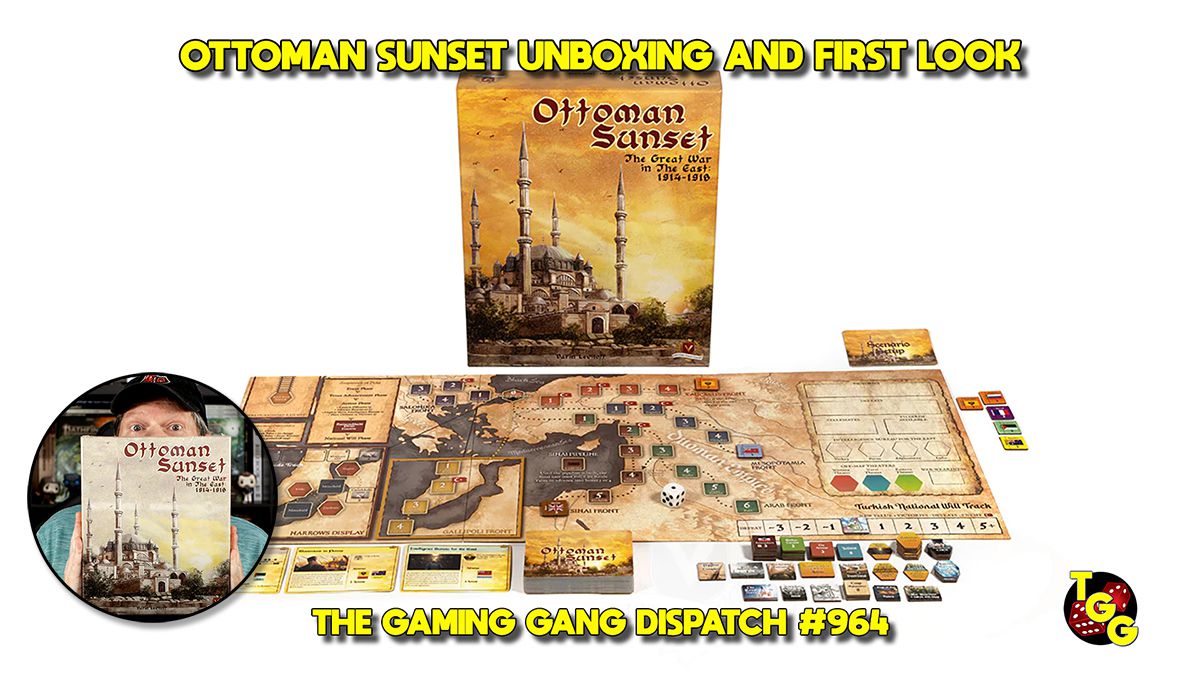












Ah… I didn’t word the attacking fronts portion properly… Thanks for correcting that Steve. But more over thanks for the great design! I’m going to toss the game in my bag for Origins so Elliott can give it a run through at the hotel. Of course, that will be after our scheduled Twilight Struggle showdown!
Thank you so much for the review – it appears that you have a good overall grasp of the design, and I appreciate your pointing out the strong narrative aspect of play (that was one of the key design goals).
One minor correction, an Allied Front can only be *successfully* attacked (and pushed back) once per turn (if you fail, you can continue the campaign by spending another available action and rolling again). The Pacific and Asia are enourmous areas, and the compressed map covers a lot of territory (plus Japanese logistical contraints and inter-service rivalry are also abstracted here).
As you also note, there is tension from the very first card – do you choose to Battle at Pearl Harbor? How quickly can you knock out ABDA and start rolling for Oil? Which of the Resource bonuses will fit in best with your chosen strategy? Will you be able to expand your defense perimeter far enough before the “sleeping giant” awakens, etc.?
This is just a taste of the Early War deck, with the Mid War and Late War deck containing various other intriguing elements.
I sincerely hope that players find the game challenging and engaging enough for a plethora of plays both now and in the future. So far, so good — long live States of Siege!
Twilight Struggle is simply the best – my favorite game of all time.
I sincerely hope that Elliott likes WMTtE, and can eventually post the review over on BGG.
I’ll also look forward to Emperor occupying some hallowed ground on your “Top Reviewed Games” list once it’s updated!